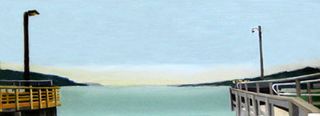
CATALOGUE ESSAY
The Hudson River School Revisited
by James Panero
"Dee Shapiro: The Hudson Line" is on view at Andre Zarre Gallery, New York, from April 27 through May 29, 2010
Where do we come from? What are we? Where are we going? Gauguin's unanswerable questions are modern art's catechism. We begin with certainties but end in mysteries. Dee Shapiro's enigmatic work star ts in places we think we know only to lead us from conclusions. Up river, down tracks, nothing coming, nothing going. What's missing amid the water, bridges, boats, stations, docks, and towns are the narratives that might satisfy our attention and permit us to move along.
Paintings are inert when they leave us alone. The energy of a work comes from how it engages us. Shapiro keeps her paintings open so we might complete them. In between the nouns we supply the verbs of our own stories. Why do we look at these stations and docks? Are we leaving on a train? Waiting for a ferry? Has someone just departed? Have we just arrived? Or are we just watching? Are we seeing a vision through someone else's eyes? The more we look the less we know.
Shapiro has been drawing small her entire career. In the landscape work of the last several years, she has compressed a CinemaScope vision into diminutive scale. The resulting images, in exquisite detail, contain as much information as you might expect from much larger paintings. What differs is our proximity to it. Shapiro compels us to look at her work up close. The absence of monumentality, like the ambiguous narrative, pulls us in, encouraging a personal exchange with the work. When we approach, we come to occupy the painting, physically, with our own size.
Each decade of art in New York has its own spirit. The ar t of the 1970s, when Shapiro came of age, had a soul. The cool supremacism of the 1960s gave way to a studio-based culture that reconnected with the processes of making art. Since the Bauhaus, modernism has sought to elevate craft to the level of painting. In New York the legacy of the Bauhaus weavers combined with a new interest in homespun folkways to create a movement called Patterns and Decoration, or P&D. The 1970s women's movement gave P&D a political timeliness. An artist working in abstract geometric pattern, Shapiro became a founding member of Central Hall, the first women's gallery on Long Island. Her early work, exhibited at Andre Zarre Gallery in the mid-1970s and now in the collection of the Guggenheim Museum, used the artist's own color system to draw and paint intricate abstract patterns based on the Fibonacci Sequence, the numerical basis for Golden Spirals and Rectangles. The process, laid on a grid, recalled textile designs and needlepoint.
P&D was a more tradition-bound movement than its political associations might suggest. It was not radical enough to be sustained by academic theory, nor bold enough to be noticed in the macho celebrity culture that took over art in the 1980s. Yet the extreme of the middle, as Jack Tworkov called it, has well suited Shapiro. Today, she continues to develop the artistic idioms she first took up forty years ago.
Shapiro’s interest in small detail that we find in the early abstractions continues through her representational paintings. The smallness of the paintings recommends them to intimate environments. Unlike the Hudson River School landscapes of the nineteenth century, with their imperial awe, Shapiro's paintings seek out the more quotidian emotions of modern life. In response to Gauguin, one might only say, we come, we are, we go. Little else is certain.
For a PDF of the entire exhibition catalogue, click here